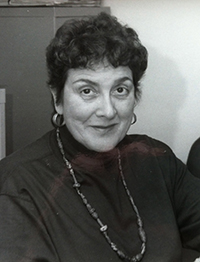
Marilyn Krukowski, PhD, professor emerita of biology in Arts & Sciences, died Sunday, April 7, 2013, in St. Louis from complications of multiple sclerosis. She was 80.
She joined the faculty at Washington University in St. Louis in 1969, became a professor in 1987 and retired as professor emerita in 2002.
Krukowski taught vertebrate structure (anatomy) in the Department of Biology for more than 30 years. Her students raved about the quality of her teaching and often cited the course as the best they ever took at Washington University.
One of her students, Allen Saxon, who graduated in 1971 and later became a surgeon, offered the following tribute to Krukowski in the “Lasting Lessons” section of Washington University in St. Louis Magazine in 2000.
“The value of her teaching was emphasized to me a year later when I was in the first year of medical school at Tulane. The workload of the second semester included two tests a week. It was a challenge just to finish the reading assignments, let alone to fully digest the material.
“The night before a test in renal physiology we had 450 pages of reading, which I hadn’t completed. Making it worse, the class lectures had been disjointed and hard to follow. Exasperated, I called a friend in the junior class who was also a WUSTL alum.
“When I explained my dilemma, he said, ‘You took comparative anatomy, didn’t you?’ I then reviewed Krukowski’s presentation on renal physiology. Those two or three lectures substituted for the 450 pages of physiology reading.
“I aced the test!” Saxon said.
Krukowski worked closely with fellow biologist Florence Moog on educational activities. Krukowski played a major role in establishing and overseeing the Florence Moog Scholarship program at Washington University.
Krukowski began her academic career as assistant professor of physiology and pharmacology at New York Medical College. After she came to Washington University, she worked variously for the Department of Biology in Arts & Sciences, the now-closed School of Dental Medicine and the Division of Bone and Mineral Diseases in the School of Medicine.
Philip Osdoby, PhD, a professor of biology in Arts & Sciences, and Julie Glowacki, PhD, a professor of orthopedic surgery and of oral and maxillofacial surgery at Harvard University, both remember Krukowski as a kind friend and generous collaborator.
“She was absorbed by questions concerning skeletal regulation of the fetal skeleton and the impact of maternal metabolism and disease on the skeletal health of the progeny. Much of her work concerned the development of osteoclasts, the cells that are responsible for bone resorption,” said Osdoby.
“She developed methods to determine that the precursors of the bone resorbing cells are in the circulation well before the development of bone itself. She and her collaborators discovered that bone matrix signals are responsible for the differentiation of precursor cells into osteoclasts,” said Glowacki.
“These studies led to the discovery that tissue response to an implant was based upon the implant’s surface charge and led to the development of charged implant materials to foster bone growth and skin wound repair. Two patents on hard and soft tissue repair were obtained for that innovative work,” said Osdoby.
Krukowski earned a bachelor of arts degree from Brooklyn College in New York in 1954 and a PhD from New York University in 1962.
She is survived by her husband, Lucian, her daughter, Samantha, and her granddaughter, Zoë.